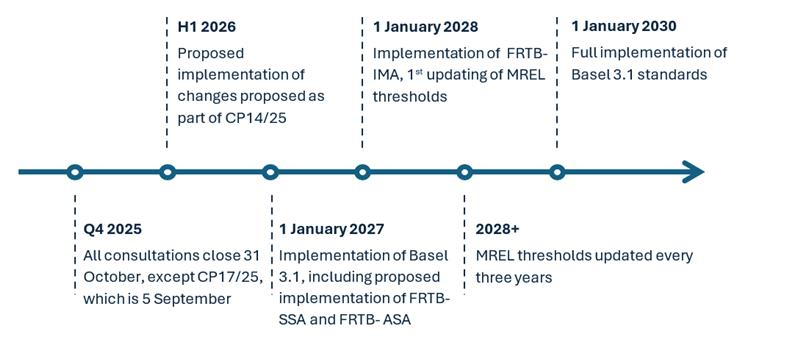There are four separate but related updates to the resolution framework:
- Resolution assessment threshold and recovery plan reviews – the primary proposal in PRA CP14/25 is the raising of the resolution assessment threshold from £50 billion to £100 billion. This is motivated by the desire to target regulatory focus and resources on systemically important firms, reduce the compliance burden on mid-sized firms and promote insolvency as a viable tool for smaller firms. The PRA also proposes to reduce the frequency with which SDDT firms need to review their recovery plans from at least annually to at least every two years. Again, this is intended to reduce administrative and regulatory burdens. However, the PRA notes that firms which are ‘new and growing’ may need to review and update their recovery plans more regularly as their business models undergo material changes.
- MREL reporting – PRA CP15/25 proposes to introduce greater standardisation and consistency in certain reporting templates for minimum requirement for own funds and eligible liabilities (MREL) reporting. The amendments are intended to improve the consistency, clarity and efficiency of the data collection process, thereby enhancing the transparency of MREL resources on a cross-firm basis, and supporting more effective resolution planning and increased operational readiness. By embedding MREL reporting into the broader resolution framework, the PRA seeks to reduce ad hoc data requests and improve the quality of information available to the BoE during resolution assessments.
- Pillar 3 disclosures – PRA CP16/25 proposes enhancements to Pillar 3 disclosures in three key areas: firms’ resolvability resources (MREL), capital distribution constraints (CDCs) and the basis for disclosure. It introduces further standardised templates for MREL disclosures to improve transparency and comparability, a narrative requirement for CDCs to clarify their impact, and a new requirement for firms to state the regulatory basis of their disclosures. These changes aim to strengthen market discipline, support financial stability and align UK standards with international norms. The proposals are tailored by firm size and systemic importance, with more extensive requirements for G-SIIs and O-SIIs, and lighter ones for smaller firms. The proposed implementation date is 1 January 2027, with disclosures beginning for the period ending 31 December 2026.
- Approach to setting MREL – the BoE has updated its December 2021 Statement of Policy (SoP) on its approach to setting minimum requirement for own funds and eligible liabilities (MREL). The new SoP will take effect on 1 January 2026.
For banks, these proposals would introduce greater transparency and accountability around their ability to be resolved in a crisis. Enhanced reporting and disclosures will require them to demonstrate, in a clear and comparable way, that they have sufficient loss-absorbing resources to support an orderly resolution. This should support better internal risk management and capital planning. The proposals to raise the resolution assessment threshold and reduce reporting frequency for SDDTS are designed to encourage growth and reduce the burden on smaller firms.
For investors and market participants, the updates should provide more reliable, standardised information to assess the resilience and resolvability of banks, reducing uncertainty and supporting more informed investment decisions and improved market confidence.
For the wider financial system, the reforms reinforce the UK’s commitment to robust resolution planning and market discipline. By aligning with international standards and increasing transparency, they should help to safeguard financial stability, protect taxpayers from bank failures and maintain the UK’s reputation as a leading global financial centre.
Taken together, the updates will impose additional assurance and transparency obligations on the largest and most complex firms by requiring them to assess, report and disclose their preparations for resolution — mid-tier firms will only be required to make a public statement on their resolvability.








